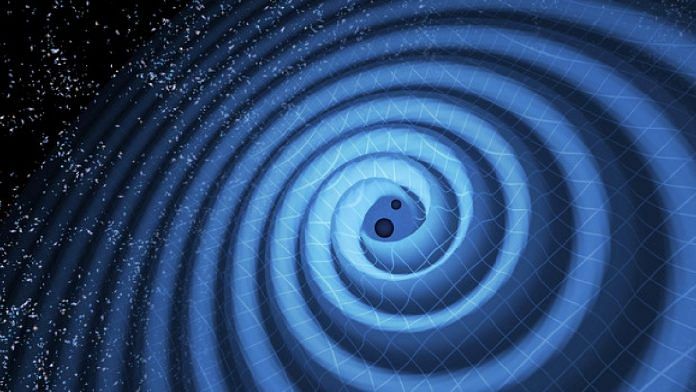Bengaluru: Astrophysicists have detected gravitational waves from an unusual merger of two asymmetric black holes, i.e., black holes with two different masses.
According to gravitational wave data from the Laser Interferometer Gravitational-Wave Observatory (LIGO) in the US and the Virgo interferometer in Italy, the two black holes had an unusually large mass difference, with one being three to four times more massive than the other.
Because of this mass imbalance, the merger produced gravitational waves that spread out in the space-time fabric in multiple frequencies.
This is the first such observation physicists have ever made, and the event also confirms another prediction made by Albert Einstein’s theory of general relativity — that of gravitational wave harmonics.
The event, called GW190412, was observed on 12 April, 2019 at 05:30:44 UTC. The Advanced Virgo detector and both Advanced LIGO detectors picked up the activity in just the second week of their third observational run. While black hole was approximately 8 solar masses, the other was around 30 solar masses. Solar mass is a unit of measurement in astronomy and is equal to the mass of the sun.
The merger occurred over 2 billion light years away.
Also read: The world gets its first look at a black hole. Here’s how we got there
Understanding gravitational waves
Gravitational waves are detected when extremely massive bodies like black holes, which can weigh anywhere from 100 to a 100 times the mass of the sun, move around in the fabric of spacetime. Their movement produces waves that can be detected by our instruments when they are engaged in high-energy events like collisions.
Other regular mergers of black hole, of which interferometers have detected 10 so far, have had comparable masses. Such collisions produce waves at a single frequency. The frequency of these waves tends to be double the orbital frequency — the two black holes swap positions after half an orbit while spiralling.
“Imagine you were listening to a symphony,” said Karan Jani, gravitational wave astrophysicist and one of the co-authors of the paper as a part of the LIGO collaboration.
The LIGO collaboration is a scientific collaboration of over 1,200 scientists from over 100 international physics institutes in 18 countries working on gravitational wave physics.
“Different frequencies from different instruments make up a composition. Now if suppose you could hear only one instrument, you would have little idea what the symphony truly sounds like,” Jani added.
This is how we’ve observed all previous collisions, where waves of only a single frequency were observed. But in asymmetric collisions, other weaker gravitational waves are also produced at higher frequencies. Such collisions help put together a clearer picture about black hole collisions.
“If you can hear other instruments, suddenly you get a much clearer picture of how the music is produced, what it actually sounds like, and whether it is a Beethoven or Hindustani classical,” said Jani as he explained the significance of studying black hole collisions.
Also read: In 2020, more black hole images will blow our minds
Why such frequencies are important
Multiple frequencies of waves can in turn help determine other parameters of the two black holes such as their spacetime orientation, how they were produced, and how such large masses interact, and so on. Gravitational waves can provide direct information about the event horizon or the boundary of the two black hole beyond which light cannot escape.
A typical analogy that would work for gravitational waves is the ripples produced on a still pond when a stone is thrown in, which emanate out on the surface. But Jani likens the asymmetric merger to two fishes, one small and one large, circling each other in a still pond. The waves produced are not all identical, and emanate at different frequencies and strengths.
“We have never seen a merger this unique,” he added. “All the black hole or neutron star collisions we’ve observed have been pairs of roughly identical masses. Collisions like this one are a great probe of Einstein’s relativity at extreme-gravity environments. These kind of waves were predicted by Einstein, so we knew that they occur, theoretically. But this is the first evidence we have recorded.”
The findings also came after LIGO was shut down due to the Covid-19 public health emergency on March 27th, 2020.
“LIGO did shutdown and that has stopped our science run prematurely,” said Jani. “But universe gave enough data to work on for a while. Scientists across the globe have pushed themselves to push this analysis while working from home.
This report has been updated to remove a reference to ‘gravitational radiation’ and its definition.
Also read: Einstein predicted blackholes in the early 1900s but their weirdness stopped him




Deez nut’s
Very interesting and informative article.
You really need to proofread this article. “from 100 to 100 times the mass of the sun”?
Good information.
Just amazing, so cool what we’re learning these days…